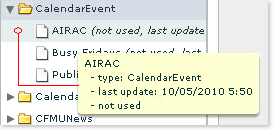Before any creation or modification of WIND Entity, you may wish to get a few basic facts on how documents are handled in the WIND interface.
The WIND File System
The WIND documents are represented by a ![]() document symbol followed by a name (and followed, in brackets, by a usage status indication and by the last update date). A WIND document is also referred to as an entity - this is how it will be named in the different menus.
document symbol followed by a name (and followed, in brackets, by a usage status indication and by the last update date). A WIND document is also referred to as an entity - this is how it will be named in the different menus.
The WIND entities are grouped in logical collections, and for that purpose stored inside folders represented by the typical ![]() folder icon.
folder icon.
As in most file systems, the folder can be either collapsed or expanded, to reveal its content (see illustrations below, with the CalendarEvent folder taken as example):
Collapsed Folder

Expanded Folder

You can also move your mouse over the listed items to get a tooltip with a summary of the hovered entity, showing its name, type, last update and usage status:

Entity status
Visual clues let you know the current status of an entity:
A padlock icon next to the entity label indicates that it is currently being edited and therefore not available for edition, until it is released.
In addition to this, a color code further clarifies its status:
- Labels are set to Green when they are being edited by yourself, within the active view in which you are currently making changes.
- They are set to Orange when edited by yourself - within any view other than the currently active one (and identified between parenthesis). You will need to return to this view in which the changes took place to resume your work.
- Labels are finally set to Red to indicate that the entity is being edited by someone else (identified between parenthesis).
Entity Title Bar
Once you have opened an entity, the Title Bar displays its Title (name), preceded for easier reference by the identifier of the collection to which it belongs:

Resize - Close - Move the Edit Window
The Title Bar also provides 4 buttons to automatically resize the Edit window:

![]() Minimize: reduces the Edit window to its title bar - the opposite action to Maximize
Minimize: reduces the Edit window to its title bar - the opposite action to Maximize
![]() Maximize: restores the Edit window to its original size - the opposite action to Minimize
Maximize: restores the Edit window to its original size - the opposite action to Minimize
![]() Full Screen: stretches the Edit window to fill the available space
Full Screen: stretches the Edit window to fill the available space
![]() Close: closes the Edit window
Close: closes the Edit window
Another way to manually resize the window is by means of the Resize Handle, located at the bottom right of the window, as highlighted below:

You can finally move the window with a standard drag-and-drop action on the title bar.
Viewing/Editing Content
There are to main methods to view or edit a WIND document - the List Mode and the Table Mode.
The List Mode
In the List Mode you will work in a way very similar to what you are used to do in your regular computing environment: open a folder, locate a document, and double-click on its name or icon, or right-click on its name or icon and select a command from the proposed contextual menu.
The Table Mode
The Table mode is quite different, as it displays the content of a WIND folder in a table format.
To work in the Table mode first locate and select the target folder, right-click on its name or icon, and select the 'Open list ...' command. The tables prove very useful for displaying and sorting long lists of documents, as you can drag the columns in your preferred sequence, and sort their content at will.
Saving changes
The WIND Editor provides two methods to persist the changes made to a document: the Apply and Ok buttons located at the bottom left of the window.
The Apply button will save the changes made to the document being edited - the OK button does the same, and in addition closes the Edit window.
Should you forget to save your changes, you will be prompted to do so when you close the Edit window.